
Soundweaving

Image: (c) Fejér János.
What does the music of embroidery sound like? An unusual question perhaps, but one that Hungarian designer Zsanett Szirmay seeks to explore in Soundweaving: an experimental interdisciplinary project that translates traditional Eastern European folk embroideries into gentle, tinkling melodies. With the help of composer Bálint Tárkány-Kovács, Szirmay treats each cross-stitch like a musical note, using embroidered shirts and pillows from the Transylvanian Bukovina, Kalotaszeg and Hungary as a basis for the patterns. By translating motifs such as tulips, pomegranates and birds onto punch cards and then running these cards through a hand-wound music box, Szirmay unlocks the latent music hidden within the textiles and brings the visual world to life through audio.

Image: (c) Sándor Fövényi.
Soundweaving transports traditional textile embroidery into an entirely new dimension, where different planes of communication stimulate multiple senses whilst blending the genres of folk art, textile design and music. Szirmay originally transcribed eleven embroideries which can be heard on the Soundweaving website. The result is a collection of ethereal, otherworldly melodies; it is almost as if the embroideries are singing.
“My inspiration came from the punch cards in weavers’ workshops. Early computers also used such punch cards, with the information coded in such formats. I thought back to my youth, seeing the music boxes in fairs and managed to connect the two concepts. Why not make pretty motifs on the punch cards? I was previously a member of a Hungarian folk dancing group, during which time I wore embroidered clothes. We often performed in villages, where I collected cross stitch patterns from pillowcases, tablecloths, shirts. Later on, I was able to transform these pattern onto the punch cards.”

Szirmay’s subsequent Soundweaving works include Japanese and Middle Eastern editions, as well as a Pergamon edition for Berlin’s Pergamon Museum. For more information visit soundweaving.hu
---
Guest blog post by Safiya Juma. Safiya is a freelance copywriter and long-time student of yoga, meditation and the healing arts. While studying textiles as an adult, Safiya discovered that her British grandmother sewed peace quilts for church whilst her Indian grandfather stitched scripture into the selvedge of East African khanga cloth. Safiya’s own textiles practise includes sacred geometry quilts and embroidered words and images she receives whilst meditating or walking in nature.
We welcome guest blog post submissions from everyone – check our guidelines for more information.
